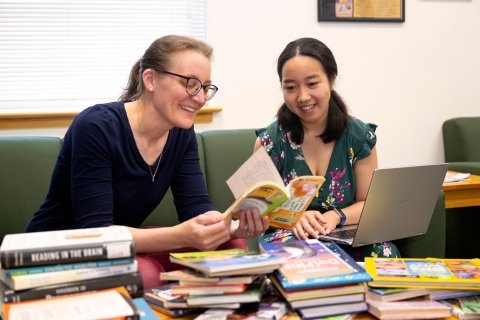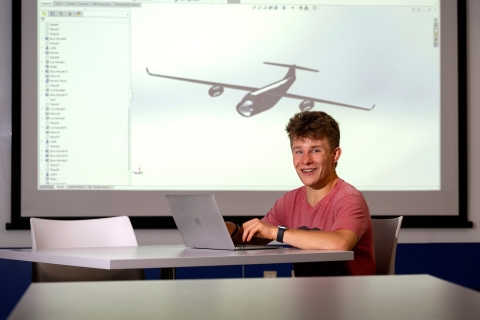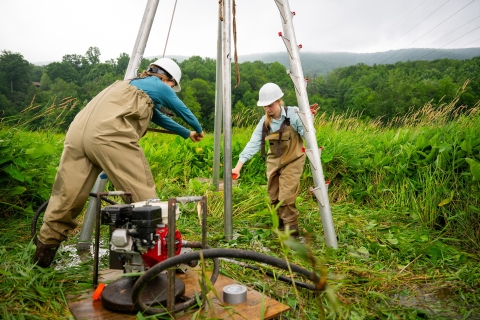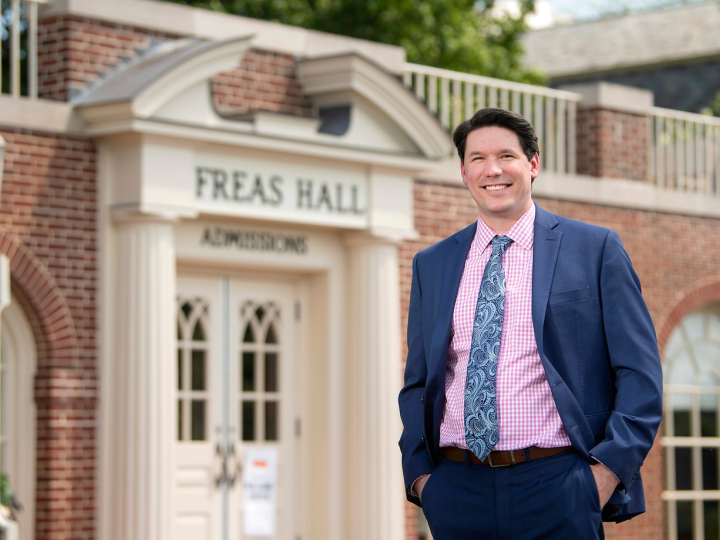
Bucknell Students Conduct Academic Investigations Over the Summer
August 5, 2025
Student researchers for Professor Lorelei Curtin, geology & environmental geosciences, conduct fieldwork to gain insight into the Holocene epoch. Photo by James T. Giffen, Marketing & Communications
The pace of university life slows down over the summer. With final exams in the rearview mirror, both students and professors have the chance to take a well-deserved vacation from the rigors of the academic year. However, even though classes are out, campus is still animated by the energy of intellectual discovery. These three Bucknellians have delved deep into their summer research projects to reveal new insights across the disciplines.
Sanda Tan '28, linguistics and computer science

Professor Heidi Lorimor, linguistics, and Sanda Tan '28, linguistics and computer science, analyzed large collections of children's books to better understand how young readers comprehend sentences. Photo by Emily Paine, Marketing & Communications
Grammar can be a daunting subject. There are countless rules and quirks that can be difficult to follow, let alone master. However, for Sanda Tan '28, a linguistics and computer science double-major from Rockford, Mich., it's the mechanics and peculiarities of language that fuel her academic passions.
"In my research, the main thing we’re trying to focus on is how children, especially second-graders, understand sentences," says Tan, who has been working with Professor Heidi Lorimor, linguistics, as part of the Emerging Scholars Summer Research, Scholarship & Creativity Program.
Together, Tan and Professor Lorimor have been feeding different children’s books into Stanza, a Python-based natural language software that allows for the analysis of large collections of text. "Our main goal is to identify which sentence and clause structures young readers are encountering in the books they're reading," says Tan.
Over the summer, Tan has been able to apply both her computational skills and linguistics background to the aims of the project. She and Professor Lorimor meet weekly to discuss theories of reading comprehension and to review the fundamentals of English grammar. The rest of the time, she can usually be found in the computer lab, where she codes the Stanza data into a comprehensive database.
Ultimately, she hopes to make the database information easily searchable and accessible. "If we know what sentence structures are present and how often they occur with young readers, then we can figure out what kind of support teachers and students need to be successful," she says.
Kade Davidheiser '27, mechanical engineering and biology

Kade Davidheiser '27, mechanical engineering and biology, spent his summer researching how electric aircraft can be integrated into the national air fleet to reduce carbon emissions. Photo by Emily Paine, Marketing & Communications
In any given year, there are over 10 million airline flights through the United States. This summer, Kade Davidheiser '27, a mechanical engineering and biology double-major from Barto, Pa., dove deep into the data of a single day to investigate what those flights reveal about carbon emissions.
"We took a screenshot that captured a full day of the radar for the National Airspace System," says Davidheiser. Along with Professor Greg O’Neill, mechanical engineering, they are analyzing the roughly 60,000 flights that occurred on March 24, 2024. The amount of data generated by a single day of air traffic in the United States is so great that the code to process it, which was written by O’Neill, takes around a month to run. "We're looking at everything from how many passengers are on a flight, how far the plane flew, and the kilowatt-hours used by each flight," says Davidheiser. "There's probably 1,000 inputs per plane, so when you multiply that by 60,000 flights, it's a massive project."
The goal of the project is to determine whether carbon emissions could be reduced by replacing petrol-based planes with electric aircraft. One of Davidheiser's main roles involves building airplanes in SolidWorks, a 3D CAD (Computer-Aided Design) software. "I'm given the wing area, the length and the amount of passengers. From there, I have to create a whole plane," he says. The design process is dynamic, and the shape and size of the aircraft changes based upon both data inputs and outputs. By modeling different types of planes, they can better understand the factors that inform carbon emissions and energy usage.
"We're writing a research paper that basically shows it’s possible to integrate electric aircraft into the national air fleet," says Davidheiser, noting that the paper will be published in the American Institute of Aeronautics and Astronautics journal.
Juliette VanLuven '26, geology

Kira Leclercq '26, environmental geosciences, and Juliette VanLuven '26, geology, extracted a core sample from The Robert Porter Allen Natural Area to gain insight into the Holocene epoch. Photo by James T. Giffen, Marketing & Communications
What drew Juliette VanLuven '26 to geology was a burning desire to understand the mysteries of the past. She wanted to know why, and how, the world came to be the way that it is today. As a Katherine Mabis McKenna Environmental Fellow, the Delmar, N.Y.-native has spent her summer searching for answers in the wetlands just outside of Williamsport, Pa.
"We don’t know exactly when the wetland formed or what the past environment of the area was composed of," says VanLuven, who has been working under the guidance of Professor Lorelei Curtin, geology. The research location, which is known both as Sylvan Dell and The Robert Porter Allen Natural Area, contains one of the largest remaining floodplain wetlands on the West Branch of the Susquehanna River. To understand its history, VanLuven and her fellow researchers have to dig down deep.
When working in the field, VanLuven's office often takes the shape of a kayak that she uses to navigate through four feet of standing water. Along with deploying ground-penetrating radar to understand what lies beneath the surface, the core of her research depends on collecting, well, a core.
"A core is basically a long tube of sediment that we remove with a special, large drill," says VanLuven. By analyzing the sedimentary makeup of the core, she can begin to reconstruct the past to determine the age of the wetland. "We’re hoping to look back into the Holocene, which encompasses roughly the last 11,700 years."
Before core samples are sent out to a lab for radiocarbon dating, VanLuven combs through the collected material, centimeter by centimeter, cataloguing everything from grain size to the presence of plant matter. Even the most minute details can offer profound insights into the world of long ago. "I have learned so much from my professors and my peers," she says. "The geology department is just such a wonderful and open space for curiosity, learning and hands-on experience."

